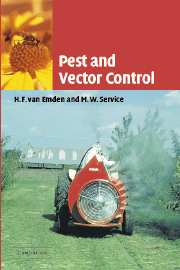Book contents
- Frontmatter
- Contents
- Preface
- 1 Man and insects
- 2 The causes of pest and vectored disease outbreaks
- 3 Insecticides and their formulation
- 4 Application of insecticides
- 5 Problems with insecticides
- 6 Environmental/cultural control
- 7 Biological control
- 8 Insect pathogens
- 9 Genetic control
- 10 Pheromones
- 11 Plant and host resistance
- 12 Other control measures and related topics
- 13 Pest and vector management
- Appendix of names of some chemicals and microbials used as pesticides
- References
- Index
11 - Plant and host resistance
Published online by Cambridge University Press: 03 December 2009
- Frontmatter
- Contents
- Preface
- 1 Man and insects
- 2 The causes of pest and vectored disease outbreaks
- 3 Insecticides and their formulation
- 4 Application of insecticides
- 5 Problems with insecticides
- 6 Environmental/cultural control
- 7 Biological control
- 8 Insect pathogens
- 9 Genetic control
- 10 Pheromones
- 11 Plant and host resistance
- 12 Other control measures and related topics
- 13 Pest and vector management
- Appendix of names of some chemicals and microbials used as pesticides
- References
- Index
Summary
Introduction
In relation to pest control on crops, the growing of varieties which are less vulnerable to attack than others (Fig. 11.1) or which yield well in spite of attack has many advantages. Once such varieties are available, pest control requires no extra labour and is therefore economical; moreover, the environment does not suffer from side-effects of the control measure.
Host plant resistance has been researched and used for many years for the control of nematodes and plant diseases. Even for insects, the potential of resistant varieties was already highlighted 50 years ago by Reginald Painter in the USA. Yet serious interest in host plant resistance to insects is much more recent, probably because insecticides give such cheap, effective and reliable control. The chemical control of nematodes and plant diseases, by comparison, has never been so reliable and cheap.
However, recent pressure to reduce pesticide applications has given the subject a new impetus. A further stimulus has been given by the fact that research carried out in the large internationally funded agricultural research stations (set up by the Consultative Group on International Agricultural Research, CGIAR) in the tropics to improve the major world crops has focused on plant breeding solutions for crop protection as well as for high yield potential.
‘Plant resistance’ poses a problem of semantics. The ability of some plants to yield better than others under pest pressure may not always be due to ‘resistance’ in a strict sense.
- Type
- Chapter
- Information
- Pest and Vector Control , pp. 215 - 241Publisher: Cambridge University PressPrint publication year: 2004



